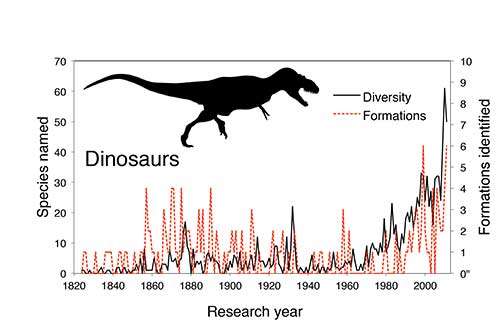
Everyone is excited by discoveries of new dinosaurs – or indeed any new fossil species. But a key question for palaeontologists is ‘just how good is the fossil record?’ Do we know fifty per cent of the species of dinosaurs that ever existed, or ninety per cent or even less than one per cent? And how can we tell?
It all depends on how we read the fossil record – the sum total of all the fossils in rocks and in museums. In a new study published today, Professor Mike Benton of the University of Bristol has explored how knowledge about dinosaurs has accumulated over the past 200 years, since the first dinosaur was named in 1824. His research does not answer the question once and for all, but it suggests that strong caution is needed with some popular methods to ‘correct’ the fossil record.
Professor Benton said: “In the past ten years, many palaeontologists have tried to find the true pattern of evolution by using measures of sampling to estimate where the fossil record is well known or poorly known. But it turns out that many of the popular methods are not doing what they are supposed to.’
Professor Benton reconstructed year-by-year, through the history of research on dinosaurs, from 1820 to 2015, how palaeontologists have discovered new species of dinosaurs, and how the patterns of discovery match the patterns of discovery of new geological formations. In fact, the patterns of discovery are closely linked: one or two new dinosaurs for each fossil-bearing geological formation that is newly explored.
This close linkage has been explained in two ways: either rocks drive fossils, or fossils drive rocks. The usual view was that rocks drive fossils: palaeontologists were keen to find new dinosaurs, but could only find them if they looked at new rocks in a new part of the world. Therefore, it could be said that the availability of appropriate rocks biases our knowledge of dinosaurs (or any other fossil group).
The opposite view is that fossils drive rocks, and that palaeontologists usually go out looking for dinosaurs in a very focused way,, and when they find them they would often add a new dinosaur-bearing formation to the list. In this case, the limiting factor is not simply the rocks, because palaeontologists do not search steadily and evenly over the ground, but they go straight to spots where they hear there are bones to be found.
“I have been worried for a while that some of the popular correction methods actually make things worse,” Professor Benton said. “By removing the numerical signal of the formations, localities, or collections they were actually removing a huge amount of real information, and producing a resulting curve that is meaningless.
“The fossil record is clearly incomplete, and it is clearly biased by many factors, but many of the supposedly ‘corrected’ diversity curves we have seen recently may actually be further from the truth than the raw data.”
The new work does not answer the question of whether we know 50 per cent of dinosaur species or less than one per cent. But it does provide a clearer picture of why there is such a close correlation between dinosaur species numbers with formations, localities or collections. The numbers of all four are connected because they are all telling pretty much the same story, and they are measuring the same history of knowledge. It is not possible to separate one or other of these measures from the others and then try to use it as an independent yardstick of sampling.
Reference:
“Palaeodiversity and formation counts: redundancy or bias?” Palaeontology, DOI: 10.1111/pala.12191
Note: The above post is reprinted from materials provided by University of Bristol.










